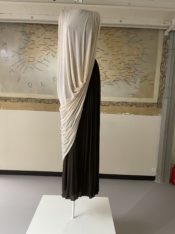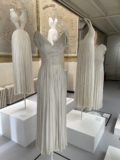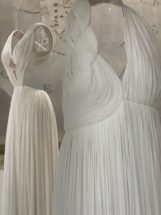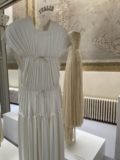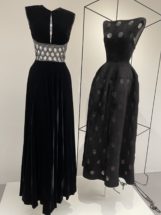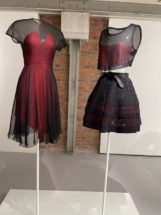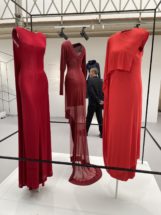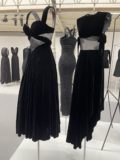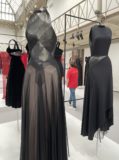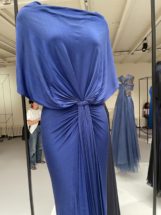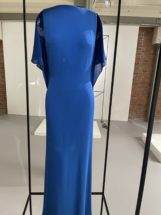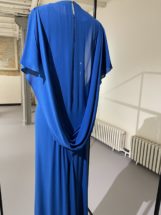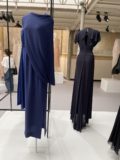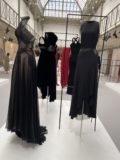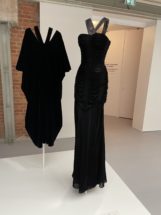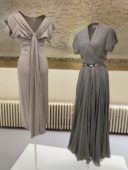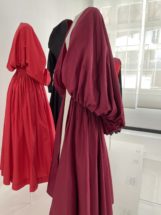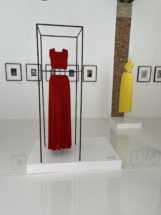Both Madame Grès and Azzedine Alaïa have a fascinating commonality; they considered themselves sculptors in a world obsessed with fashion. While Grès has been influencing the art of drapery since the ’30s, Alaïa elevated the practice of cutting fabric into an art form, thanks in part to his fine arts background in sculpture.
Did these two icons ever cross paths? Probably not. But their works did, and oh, what a conversation they have. Both designers had an unwavering commitment to the details: fabric selection that spanned weeks, meticulous cuts, and a color palette that rarely veered from monochromatic shades of black and white.
The beauty of Grès’ art lies in her knack for drapery, something Alaïa also mastered with his long, flowing dresses. While Grès was a queen of jersey, Alaïa took the baton, delving into knitwear and other soft materials. Both designers showed an uncanny precision in cutting, a trait that united them in their pursuit of perfection.
Madame Grès once said, “Once you find something that is personal and unique, you must fully exploit it and pursue its realization without stopping, until the very end.” Alaïa echoed this sentiment, saying, “When an idea imposes itself on you, you have to lasso it, turn around it, and never deviate from it.”
For the first time, an unprecedented exhibition brings together the works of Madame Grès and Alaïa. United by their formal principles, their cutting techniques, and the harmonious combinations of fabric and colors they commonly embraced, the evening gowns and day dresses by both couturiers invite visitors to a lesson beyond fashion. Timeless for one, and outside of time for the other, the exhibited creations, totaling 60, restore the dialogue between Grès and Alaïa, two solitary and determined individuals who became sculptors of dresses.
Madame Grès, whose real name was Germaine Krebs, began working in the 1930s. In 1933, on rue de Miromesnil in Paris, she joined forces with Julie Barton to open the house Alix Barton, which became Maison Alix in 1934 on rue du Faubourg-Saint-Honoré. She quickly achieved great success with her designs reminiscing of antique statuary and at the same time perfectly adapted to modern life thanks to her own draping technique. Following disputes with her associates, Germaine Krebs founded the house Grès in 1942, an anagram of her husband Serge’s first name. She established the white salons of her house and its workshops at 1 rue de la Paix, right in the heart of Paris. Indifferent to the trends and fads of the decades, Madame Grès presented her timeless collections here until 1987. Among her famous clients were Greta Garbo, Marlene Dietrich, Maria Casares, Delphine Seyrig, and Grace Kelly.
Azzedine Alaïa, Franco-Tunisian couturier, has created an exceptional body of work in the fashion industry, earning him his reputation as one of the most talented designers of his generation. Upon his arrival in Paris in 1956, Azzedine Alaïa worked as a couturier for a private clientele. He was particularly influenced by the timeless elegance of some of his clients, such as Louise de Vilmorin, Arletty, Simone Zehrfuss, Cécile de Rothschild or Greta Garbo. He presented his first ready-to-wear collection in 1982. He always remained closely connected to women, some of whom became his muses, including Grace Jones and Tina Turner. He also contributed to launching the careers of several models, including Naomi Campbell, Farida Khelfa, Stephanie Seymour, Tatjana Patitz, Cindy Crawford, and Veronica Webb. Alaïa is one of the last couturiers to master every stage in the design and production of a garment. A master of cut and a worthy successor to the couture masters, he is also a great collector, having acquired over 15,000 pieces, bearing witness to the creations of fashion history in the 19th and 20th centuries. These include 700 dresses by Madame Grès now owned by the foundation that he wished for. A selection of models and photographs are being presented for the first time in the exhibition spaces.
If you’re in Paris between September 11 and November 2, take a moment to witness this quiet but profound dialogue between two creators who saw themselves as much more than ‘just’ fashion designers. It’s an exhibition that’s less about the fashion industry and more about two artists who mastered the fine art of dressmaking.
Later,
Diane


